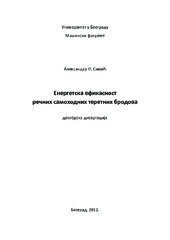Приказ основних података о дисертацији
Енергетска ефикасност речних самоходних теретних бродова
Energy efficiency of inland waterway self-propelled cargo vessels
| dc.contributor.advisor | Hofman, Milan | |
| dc.contributor.other | Radojčić, Dejan | |
| dc.contributor.other | Čolić, Vladeta | |
| dc.creator | Simić, Aleksandar P. | |
| dc.date.accessioned | 2016-01-05T12:01:54Z | |
| dc.date.available | 2016-01-05T12:01:54Z | |
| dc.date.available | 2020-07-03T08:41:04Z | |
| dc.date.issued | 2012-11-01 | |
| dc.identifier.uri | https://nardus.mpn.gov.rs/handle/123456789/2309 | |
| dc.identifier.uri | http://eteze.bg.ac.rs/application/showtheses?thesesId=614 | |
| dc.identifier.uri | https://fedorabg.bg.ac.rs/fedora/get/o:6783/bdef:Content/download | |
| dc.identifier.uri | http://vbs.rs/scripts/cobiss?command=DISPLAY&base=70036&RID=514016163 | |
| dc.description.abstract | Дисертација је проистекла из вишегодишњег истраживања проблема погона речних самоходних теретних бродова. Хидродинамичке појаве које су последица сложених услова у којима плове речни самоходни теретни бродови чине избор адекватног пропулзивног комплекса при пројектовању веома сложеним, али и изазовним задатком. Посебан проблем представља недостатак метода за одређивање утицаја ограничења пловног пута на хидродинамичку ефикасност. Одатле проистичу и потешкоће при одређивању укупне енергетске ефикасности бродова овог типа. На основу свих података прикупљених из литературе до којих је било могуће доћи, али и доступних извештаја, оформљена је база са основним димензијама и резултатима мерења апсорпције снаге великог броја различитих типова речних самохотки. Формирана база је послужила као основа за истраживања хидродинамичких појава до којих долази при пловидби. У оквиру истраживања је спроведен низ непосредних мерења апсорпције снаге на бродовима у реалним условима. Ово је омогућило проширење формиране базе, али и указало на комплексност поступка мерења из чега проистичу некада и велике разлике између расположивих резултата мерења апсорпције снаге на истом броду, али и између моделских испитивања и испитивања бродова у природној величини. На основу резултата моделских испитивања развијен је математички модел помоћу кога се за познате димензије и носивост брода, као и ограничења пловног iv пута може проценити снага коју је неопходно ангажовати у циљу постизања жељене брзине... | sr |
| dc.description.abstract | This dissertation has originated from many years of research on the issue of propulsion of inland-waterway self-propelled cargo vessels (IWV). Hydrodynamic effects stemming from complex conditions related to IWV navigation make selecting the appropriate propulsion system during the project phase a very complex and challenging task. A particularly important issue is the scarcity of methods for determining the influence of waterway restrictions on hydrodynamic efficiency. This produces difficulties when determining the overall energy efficiency of these ship types. Based on all the data collected from the available references and reports, a database was created containing basic dimensions and results of power absorption measurements of many different types of IWV. The data served as a basis for research devoted to navigation-related hydrodynamic effects. During the course of the research, numerous direct measurements of ship power absorption in realistic conditions were performed. This enabled the expansion of the aforementioned base, but also indicated the complexity of measurement methods, which occasionally produce considerable differences between the available results of power absorption measurements of the same ship, but also between examinations of models and corresponding full-scale IWV. Based on the available results of model-scale examinations, a mathematical model was developed that can determine the power required for achieving the desired speed, on the basis of the known ship dimensions and displacement, as well as waterway restrictions. The analysis of full-scale ships examinations and comparisons of model and full-scale measurements, along with the application of existing methods of determining the effects of external influences, led to the formulation of recommendations for estimating power vi power margin. A method was indicated, based on the examination of full-scale ships, whereby the propulsion coefficients depending on waterway restrictions can be determined... | en |
| dc.format | application/pdf | |
| dc.language | sr | |
| dc.publisher | Универзитет у Београду, Машински факултет | sr |
| dc.rights | openAccess | en |
| dc.rights.uri | https://creativecommons.org/licenses/by-nc-nd/4.0/ | |
| dc.source | Универзитет у Београду | sr |
| dc.subject | отпор самохотки | sr |
| dc.subject | ship resistance | en |
| dc.subject | ограничења пловног пута | sr |
| dc.subject | мерење момента на пропелерском вратилу | sr |
| dc.subject | математички модел | sr |
| dc.subject | вештачке неуронске мреже | sr |
| dc.subject | апсорпција снаге | sr |
| dc.subject | коефицијенти пропулзије | sr |
| dc.subject | спољашњи утицаји | sr |
| dc.subject | додатак за службу | sr |
| dc.subject | индекс енергетске ефикасности | sr |
| dc.subject | waterway restrictions | en |
| dc.subject | propeller-shaft torque measurements | en |
| dc.subject | mathematical model | en |
| dc.subject | artificial neural network | en |
| dc.subject | power absorption | en |
| dc.subject | propulsion coefficients | en |
| dc.subject | external influences | en |
| dc.subject | power margine | en |
| dc.subject | energy efficiency design index | en |
| dc.title | Енергетска ефикасност речних самоходних теретних бродова | sr |
| dc.title | Energy efficiency of inland waterway self-propelled cargo vessels | en |
| dc.type | doctoralThesis | en |
| dc.rights.license | BY-NC-ND | |
| dcterms.abstract | Хофман, Милан; Радојчић, Дејан; Чолић, Владета; Симић, Aлександар П.; Energetska efikasnost rečnih samohodnih teretnih brodova; | |
| dc.identifier.fulltext | https://nardus.mpn.gov.rs/bitstream/id/7007/Disertacija.pdf | |
| dc.identifier.fulltext | http://nardus.mpn.gov.rs/bitstream/id/7007/Disertacija.pdf | |
| dc.identifier.doi | 10.2298/bg20121101simic | |
| dc.identifier.rcub | https://hdl.handle.net/21.15107/rcub_nardus_2309 |


